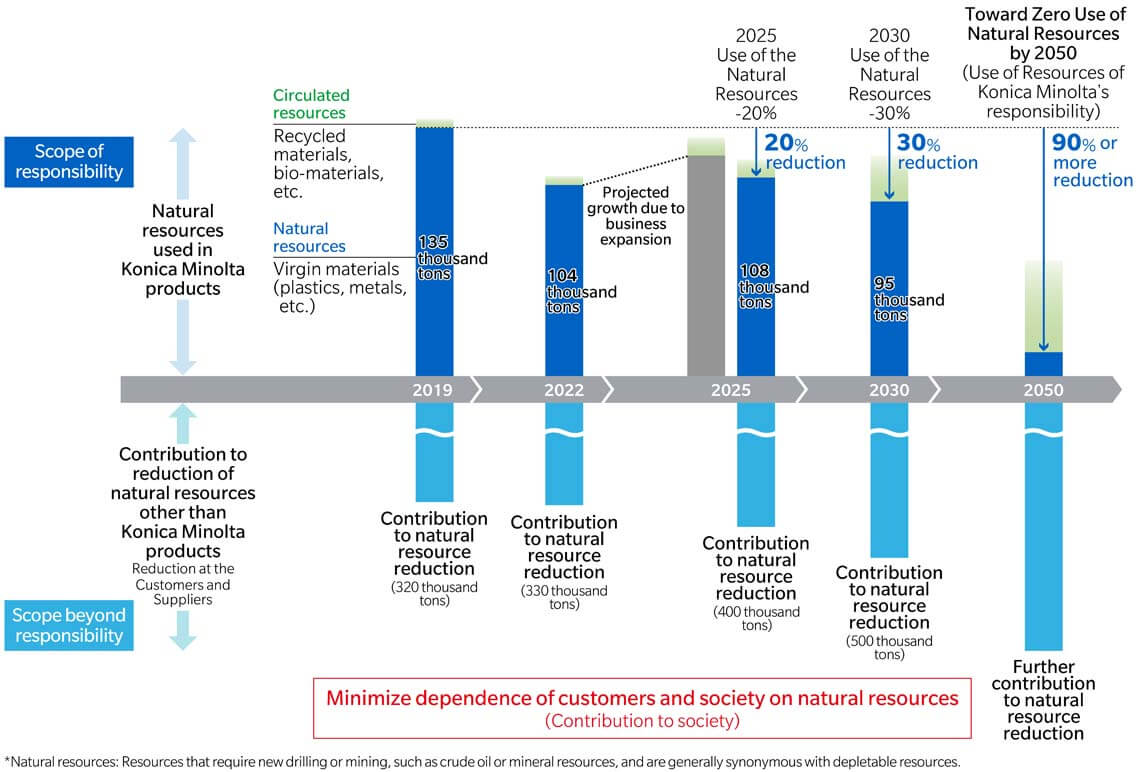Material Issue 5
Using Limited Resources Effectively
Background
|
Social and environmental issue outlook for 2030 Given the world's growing population and the growing rate of resource consumption, it is estimated that the equivalent of two earths will be needed by 2030. In order to make more effective use of limited resources, companies need not only to recover and recycle waste, but also to reduce the volume of resources wasted. |
|
Opportunities for Konica Minolta to create value, and risks to be minimized |
|||
|
|
||
Vision for 2030 and Medium-Term Plan
Vision for 2030: Promote the effective use of resources at Konica Minolta, while also helping corporate clients and suppliers to achieve effective use.
Related SDGs: ![]()
・ Results of Previous Medium-Term Plan
| Themes | Indicators | Results | Targets | ||||
|---|---|---|---|---|---|---|---|
| FY2020s | FY2021 | FY2022 | FY2022 | ||||
| Effective Use of Resources by Transforming Customer Business Processes | Social and environmental value | Reduction of waste discharge of customers (thousand tons) | 320 | 320 | 340 | 350 | |
| Economic value | Solution sales (billion yen) | 53 | 59.9 | 79.3 | 78 | ||
| Effective Use of Resources Relating to Konica Minolta Sites, Suppliers, Products and Services | Reductions to environmental impact from Konica Minolta production sites*1 | Social and environmental value | Reduction of waste discharge (thousand tons)*2 | 0.6 | 1.3 | 1.7 | 1.7 |
| Economic value | Monetary equivalent of waste reductions (million yen) | 130 | 260 | 470 | 300 | ||
| Reduction of environmental impact through the use of Konica Minolta products and services | Social and environmental value | Amount of resources saved and recycled (thousand tons) | 12 | 12 | 12 | 15 | |
| Economic value | Sustainable solution sales (billion yen) | 676 | 597 | 777 | 690 | ||
New Medium-Term Plan for FY2025
| Themes | Indicators | Targets | ||||
|---|---|---|---|---|---|---|
| FY2023 | FY2024 | FY2025 | ||||
| Effective Use of Resources by Transforming Customer Business Processes | Social and environmental value | Reduction of waste discharge of customers (thousand tons) | 360 | 380 | 400 | |
| Economic value | Solution sales (billion yen) | 89 | 97 | 100 | ||
| Effective Use of Resources Relating to Konica Minolta Sites, Suppliers, Products and Services | Reductions to environmental impact from Konica Minolta production sites*1 | Social and environmental value | Reduction of waste discharge (thousand tons)*2 | 0.2 | 0.5 | 0.8 |
| Economic value | Monetary equivalent of waste reductions (million yen) | - | - | - | ||
| Reduction of environmental impact through the use of Konica Minolta products and services | Social and environmental value | Amount of resources saved and recycled (thousand tons) | 13 | 14 | 14 | |
| Economic value | Sustainable solution sales (billion yen) | - | - | 840 | ||
- Note:
- Targets and results have been revised retrospectively to fiscal 2020 figures as the method of calculating the effects of measures was changed.
- *1
- Cumulative reduction effect for each fiscal year from FY2020 to FY2022 and FY2023 to FY2025. Total reduction effects of measures implemented from the first year of each fiscal year to the relevant fiscal year for each year.
- *2
- Targets set for plastic waste reduction and recycling activities based on the Law for Recycling Plastic Materials enacted in Japan, including the reduction of plastic waste at major sites in Japan.
Konica Minolta's Approach
In 2023, Konica Minolta set a new vision for the materiality “Using limited resources effectively” and added it as one of the items in Eco Vision 2050. The Company will reduce resource consumption and expand its use of recyclable resources to reduce its dependence on the earth’s resources* to zero by 2050 for the resources used in its products.
To reduce the use of the earth’s resources in products other than its own, Konica Minolta will help transform work-styles and manufacturing processes that make effective use of the resources of customers and society through on-demand production and imaging IoT using the solutions it provides.
For example, in the field of commercial printing, the company is providing support for the transition to on-demand printing, thereby transforming the business model of mass production and disposal. The widespread use of Konica Minolta products for small-batch, decentralized printing can accelerate innovation in the printing industry’s supply chain while achieving resource conservation and waste reduction.
Moreover, Konica Minolta will not only effectively use renewable materials that contribute to waste reduction in the broader society, but also leverage DX technologies to promote collaboration with even more corporate clients and business partners, taking on the challenge of broad-scale environmental impact reduction. It will promote the creation of circular models linked to business models.
*Natural resources: Resources that require new drilling or mining, such as crude oil or mineral resources, and are generally synonymous with depletable resources.

Businesses: Effective Use of Resources by Transforming Customer Business Processes
●Eliminating inventory and disposal in customer processes using on-demand printing and production
●Reducing customer workflow and supply chain loss utilizing materials and process technologies that use them
●Contributing to resource recycling through sensing technology
Internal Action: Effective Use of Resources Relating to Konica Minolta Sites, Suppliers, Products and Services
●Reducing environmental impact and costs at Konica Minolta sites
●Reducing supplier environmental impact and costs using DX
●Creating circular models linked to business models

